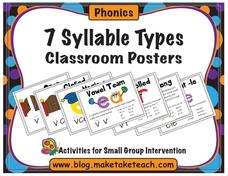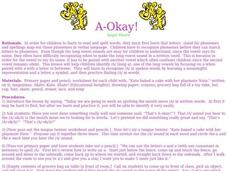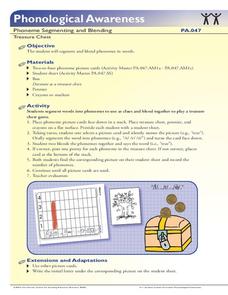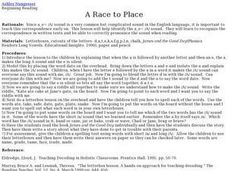Curated OER
VCe Rule Accuracy
Explore word structure by participating in a vowels and consonants activity with young readers. They will read words their teacher points out in class and pronounce them correctly. Then they identify the words they say which have a...
Curated OER
VCe Rule Fluency
Explore English by identifying word structures. Learners find many words that end with a vowel, consonant, and then an e. The class will participate in a word flash card game in which they correctly pronounce vowel-consonant words.
Curated OER
Long Vowels – Silent Ee Rule Practice – The Magic Ee – Long Vowel Uu
In this grammar and spelling worksheet, 2nd graders fill in the blanks in 8 sentences with the missing vowels that complete a word. They determine which vowels should be added to the consonants that are already shown by working with the...
Make Take Teach
7 Syllable Types - Classroom Posters
Review r-controlled words, open and closed vowels, and dipthongs with a set of classroom posters. Each page features one concept with a colorful illustration, an explanation, and a list of applicable words.
Curated OER
Consonant-Vowel-Consonant-e Words
In this recognizing the pronunciation of consonant-vowel-consonant words and consonant-vowel-consonant-e words worksheet, students say the words without the final e and then with the final e and practice writing the words. Students write...
Curated OER
A-Okay
Learners distinguish between short and long vowel /a/ sounds. They are introduced to the vowel-consonant-e pattern that changes short vowel sounds into long vowel sounds. Then they practice identifying words with the vowel-consonant-e...
Curated OER
A Gift for Charlie's Mum-- Ch Words
In this language arts worksheet, students learn about "ch" words by reading a 1 page story and answering 15 questions. This page is from the UK.
Florida Center for Reading Research
Phonological Awareness - Phoneme Segmenting and Blending, Treasure Chest
Working in pairs, scholars use picture cards to practice segmenting words into phonemes and blending phonemes into words. When a peer answers correctly they place a penny in a treasure chest. Incorrect responses make the card go back in...
Curated OER
A Model Lesson Plan for Teaching Phonics
First graders decode words containing the letter o when it is followed by a consonant and silent e.
Curated OER
Say it. Write in the I and E. Read it.
In this phonics worksheet, students say the name of each of the twelve pictures. They trace the consonants and add the i and silent e to each word.
Curated OER
Pronunciation of Final Consonants
Students in ESOL classes discover how to recognize and pronounce final consonant sounds. With partners, they read passages aloud and practice the correct pronunciation. Students emphasize pronouncing the final consonant and attempt to...
Curated OER
Guided Reading with Two Sweet Peas
Second graders read the book, Two Sweet Peas. Working in guided reading groups, they discuss moving, making friends, and the differences between poems and stories. They read the book silently and discuss the importance of being kind and...
Curated OER
Guided Reading with Ten Oni Drummers
Second graders read the book, Ten Oni Drummers. Working in guided reading groups, they discuss fantasy as a genre and preview the book. They review word identification strategies and read the book silently. After reading, they confirm...
Curated OER
At The Firehouse With Dad
Young scholars participate in a guided reading of the children's book "At The Firehouse With Dad" They improve reading comprehension skills with the use of independent practice. The students then answer discussion questions while reading...
Florida Center for Reading Research
Treasure Chest
Segmenting and blending phonemes helps budding readers understand words. Use this strategy in an engaging game where partners test each other's auditory processing using familiar words. Using picture cards and a chart (included),...
Curated OER
Some Spelling Rules
This presentation offers up some of the trickier rules of the English language when it comes to spelling. For example, one slide goes over the "i before e, except after c," rule. The rest of the slides present examples like this one and...
Curated OER
Made You Mad
Students explore the phoneme for the vowel-consonant-silent e grapheme. They recognize the silent "e" at the end of words and practice speaking them. Students say words, spell them, and say tongue twisters with the vowel differences. ...
Curated OER
Hi, My Name is A
Students distinguish between short vowel a and long vowel a. They are introduced to the vowel-consonant-e pattern that changes short vowel sounds into long vowel sounds. They practice decoding pseudo words with the vowel-consonant-e...
Curated OER
We Want W!
First graders recognize the phoneme /w/. Through listening and matching activities, 1st graders discriminate the phoneme /w/ from other letters and phonemes. They associate /w/ with its letter representation and identify the phoneme in...
Curated OER
ADULT ESOL LESSON PLAN--Skills Necessary to Listen, Speak, Read and Write Effectively
Students, using a basic word picture dictionary, review the vocabulary terms on the board in conjunction with the picture dictionary and tie the two together for placement association. In addition, they practice using key grammar words...
Curated OER
Beginning, Middle, or End?
Here's a worksheet to help students become familiar with where to find words in a dictionary. Students whether the each of the 15 flower related words would be found at the beginning, middle or end of the dictionary.
Curated OER
Smart Board Syllable Activity
Young scholars divide words, using syllable division rules. They divide two and three syllable words. They follow Orton-Gillingham rules and use the first three division rules.
Curated OER
Introduce the VCe rule (Long i)
Students sound out the word "made" as the teacher reviews the rule for silent e making vowels say their names. In this phonics activity, students continue to sound out words with other long vowels and the silent e, with teacher guidance.
Curated OER
A Race to Place
Students distinguish between short vowel a and long vowel a. They are introduced to the vowel-consonant-e pattern that changes short vowel sounds into long vowel sounds. They practice spelling words with the vowel-consonant-e pattern.

























